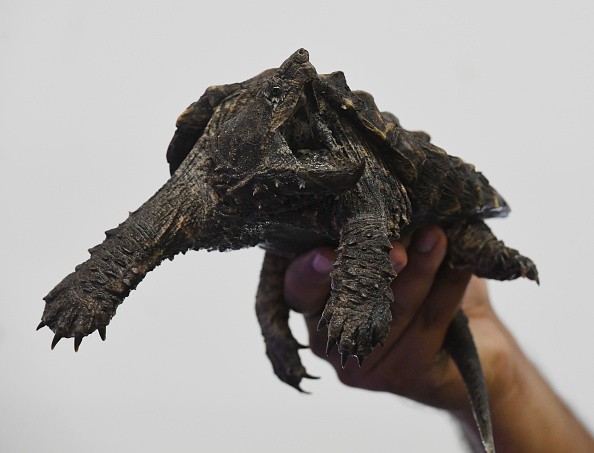The United States Fish and Wildlife Service has suggested that alligator snapping turtles - a huge, spike-shelled reptile that can be found at the bottom of lakes and slow streams and usually tempts prey into their jaws with a wormlike lure - be categorized as a threatened species.

Protection of Alligator Snapping Turtles
Environmental lawyer Elise Bennett, according to a press release says that alligator snappers are the toughest and wildest animals in the Southeast, but overexploitation and habitat devastation have placed their lives on the line.
Decades and decades of exploitation have taken a toll on the turtles, says Bennett, whose group is fighting for the turtles' protection.
With a maximum weight of 249 pounds (113 kg), the male alligator snapping turtle has been reported to live for an estimated 80 years. Bones can even be broken with their powerful teeth.
The Fish and Wildlife Service revealed Monday in an online preview of a Federal Register notice planned on Tuesday that an estimated 360,000 exist in 12 states, but without protection, their numbers are anticipated to fall to 5 percent of that number or fewer in 30 to 50 years.
This species was once only found in Kansas and Indiana but has now spread to a number of states in the southern United States.
The Mississippi and its tributaries flow through all of the states. In April, the Suwannee alligator snapping turtle, which is can be seen in the Suwannee River basin in Georgia and Florida, was suggested threatened status by the US Fish and Wildlife Service.
Turtle Soup: Possible Cause of the Reptiles' Population Decline
Alligator snapping turtles are only lawful to capture in Louisiana and Mississippi, where recreational fishermen are allowed one per day, according to the federal agency.
If the turtles are placed on the endangered species list after a public comment period, Bennett added, this practice would be outlawed.
According to a Fish and Wildlife Service notice, commercial harvests of turtle soup items peaked in the late 1960s and early 1970s.
Additionally, numerous restaurants offered turtle soup and obtained vast amounts of alligator snapping turtles from fishers in the southern United States, as per the federal agency.
As many as three to four tons of alligator snapping turtles were taken daily from the Flint River in Georgia in the 1970s due to increased consumer demand for turtle meat.
Reproduction in Snapping Turtles
It takes an average of 31 years for these long-lived creatures to properly procreate, according to the agency, and sexual maturity doesn't occur until they are 11 to 21 years old.
Furthermore, they don't lay many eggs and many other animals devour eggs and young turtles, therefore the random capture has long-term consequences.
The average number of eggs laid by an alligator snapping turtle clutch is 27, whereas the average number of eggs laid by a sea turtle clutch is 110.
Despite this, the notification said that in 2017, three individuals were convicted of illegally capturing and transporting 60 big alligator snapping turtles from Texas to another state.
Even though they are now protected in every state where they ever lived, the lasting impacts of the turtle soup trade remain a major factor in the species' decline.
Related Article : Invasive Alligator Snapping Turtle Caught in Oregon
For more news, updates about snapping turtles and similar topics don't forget to follow Nature World News!
© 2025 NatureWorldNews.com All rights reserved. Do not reproduce without permission.





